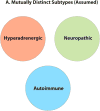Postural Tachycardia Syndrome: Beyond Orthostatic Intolerance
- PMID: 26198889
- PMCID: PMC4664448
- DOI: 10.1007/s11910-015-0583-8
Postural Tachycardia Syndrome: Beyond Orthostatic Intolerance
Abstract
Postural tachycardia syndrome (POTS) is a form of chronic orthostatic intolerance for which the hallmark physiological trait is an excessive increase in heart rate with assumption of upright posture. The orthostatic tachycardia occurs in the absence of orthostatic hypotension and is associated with a >6-month history of symptoms that are relieved by recumbence. The heart rate abnormality and orthostatic symptoms should not be caused by medications that impair autonomic regulation or by debilitating disorders that can cause tachycardia. POTS is a "final common pathway" for a number of overlapping pathophysiologies, including an autonomic neuropathy in the lower body, hypovolemia, elevated sympathetic tone, mast cell activation, deconditioning, and autoantibodies. Not only may patients be affected by more than one of these pathophysiologies but also the phenotype of POTS has similarities to a number of other disorders, e.g., chronic fatigue syndrome, Ehlers-Danlos syndrome, vasovagal syncope, and inappropriate sinus tachycardia. POTS can be treated with a combination of non-pharmacological approaches, a structured exercise training program, and often some pharmacological support.
Figures


References
-
- Freeman R, Wieling W, Axelrod FB, Benditt DG, Benarroch E, Biaggioni I, Cheshire WP, Chelimsky T, Cortelli P, Gibbons CH, Goldstein DS, Hainsworth R, Hilz MJ, Jacob G, Kaufmann H, Jordan J, Lipsitz LA, Levine BD, Low PA, Mathias C, Raj SR, Robertson D, Sandroni P, Schatz I, Schondorff R, Stewart JM, van Dijk JG. Consensus statement on the definition of orthostatic hypotension, neurally mediated syncope and the postural tachycardia syndrome. Clin Auton Res. 2011;21:69–72. - PubMed
-
- Robertson D. The epidemic of orthostatic tachycardia and orthostatic intolerance. Am J Med Sci. 1999;317:75–77. - PubMed
-
- Fu Q, Witkowski S, Okazaki K, Levine BD. Effects of gender and hypovolemia on sympathetic neural responses to orthostatic stress. Am J Physiol Regul Integr Comp Physiol. 2005;289:R109–R116. - PubMed
Publication types
MeSH terms
Grants and funding
LinkOut - more resources
Full Text Sources
Other Literature Sources

